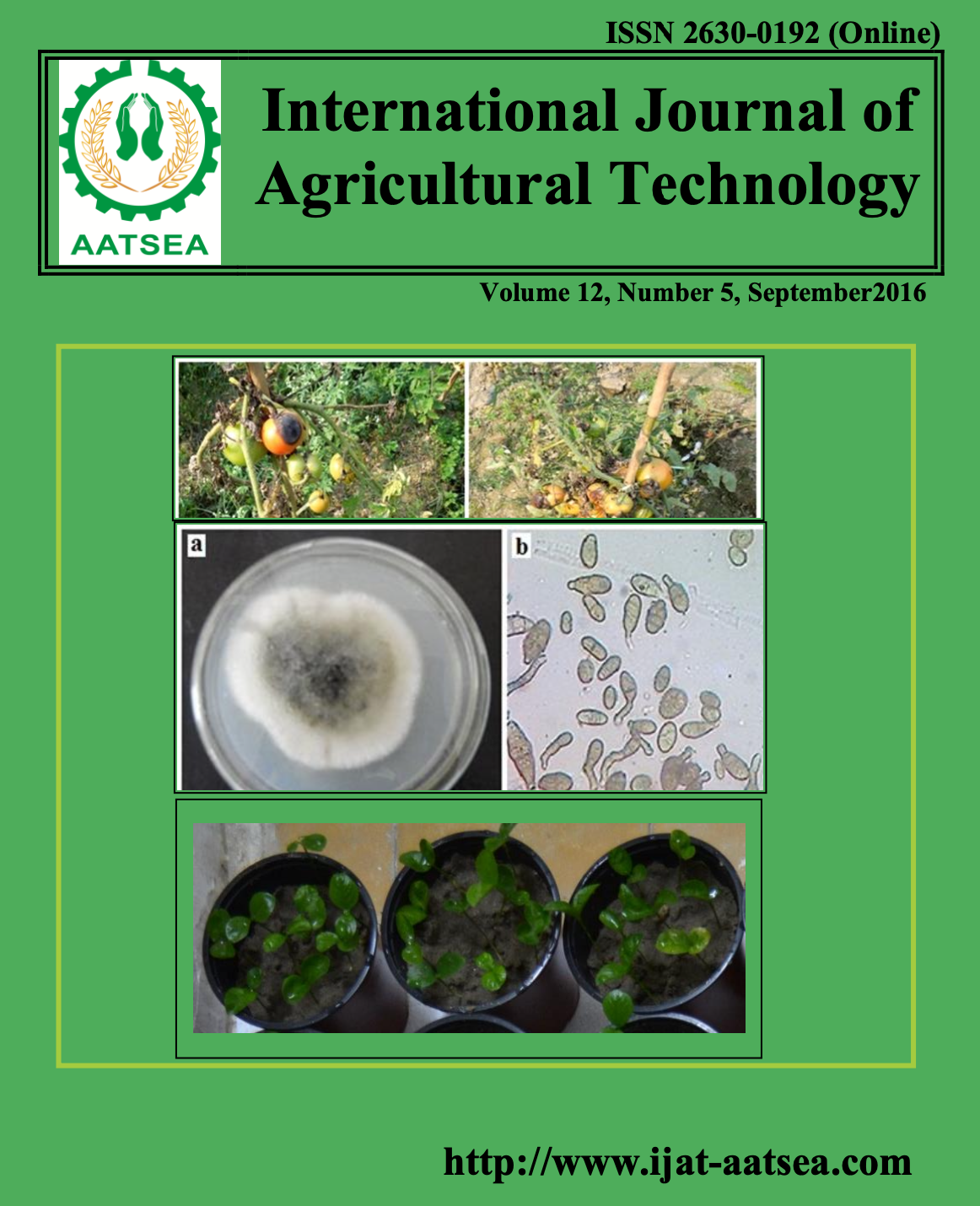Amino acid composition and nutritional value of seed proteins in sesame (Sesamum indicum L.) cultivars grown in Vietnam
Main Article Content
Abstract
Seeds of six sesame cultivars collected from different provinces of Vietnam were used for the research. The sesame seeds were selected, dehydrated, ground and stored at 4oC for analyses. The samples were hydrolyzed. The analysis of total amino acid contents and amino acid composition were carried out with precolumn derivatization technique (in HP - Amino Quant Series II, Hewlett Packard) using ortho-phthadialdehyd (OPA) for primary amino acids and 9-fluorenyl methyl chloroformat (FMOC) for secondary amino acids. The results shown that the total seed amino acid contents of the six cultivars ranged from 17.25 to 21.98%. Among six cultivars, the highest total amino acid contents was were observed in seed of two cultivars, V5 (21.98%) and V14 (21.60%). The seeds of V8 cultivar contained the smallest total amino acid contents (17.25%). All essential amino acids were found in the seeds of six examined sesame cultivars. The contents of these amino acids in seed proteins were approximate or higher in compared to FAO standard protein. The seed proteins of these six sesame cultivars had good nutritional values based on the high content of essential amino acids, lysine and leucine especially.
Article Details

This work is licensed under a Creative Commons Attribution-NonCommercial-NoDerivatives 4.0 International License.
References
Bahkali, A. H., Hussain, M. A. and Basahy, A. Y. (1998). Protein and oil composition of sesame seeds (Sesamum indicum L.) grown in the Gizan area of Saudi Arabia. International journal of food sciences and nutrition 49:409-414.
Chung, C. H., Yee, Y. J., Kim, D. H., Kim, H. K. and Chung, D. S. (1995). Changes of lipid, protein, RNA and fatty acid composition in developing sesame (Sesamum indicum L.) seeds. Plant Science 109:237-243.
Cooney, R. V., Custer, L. J., Okinaka, L. and Franke, A. A. (2001). Effects of dietary sesame seeds on plasma tocopherol levels. Nutr Cancer 39:66-71.
Dang, T. L., Tu, G., Tu, N. and Le, T. T. (1997). Use of sesame powder to prepare food for babies at 12-36 monhts of age. Journal of Preventive Medicine 7:78-80.
El-Adawy, T. A. (1995). Effect of sesame seed proteins supplementation on the nutritional, physical, chemical and sensory properties of wheat flour bread. Plant Foods for Human Nutrition 48:311-326.
Elleuch, M., Bedigian, D., Zitoun, A. and Zouari, N. (2011). Sesame (Sesamum indicum L.) seeds in food, nutrition and health. Nuts and seeds in health and disease prevention 1029-1036.
FAO/WHO/UNU. (1991). Protein quality evaluation. Rome, Italy: Food and Agricultural organization of the United Nation.
Kang, M. H., Choi, J. S. and Ha, T. Y. (2003). Chemical properties of sesame seed cultivated in Korea and China. Food Science and Biotechnology 12:621-624.
Kanu, P. J. (2011). Biochemical analysis of black and white sesame seeds from China. American Journal of Biochemistry and Molecular Biology 1:145-157.
Le, Q. V., Hoang, V. S. and Phan, X. T. (2005). Bio-chemical and food indexes of three sesame cultivars in the coastal sand area in Nghe An provine. Journal of Biology 27:46-49.
Maneemegalai, S. and Prasad, R. (2011). Evaluation of amino acid composition and protein solubility profile of commercially available sesame and groundnut seed meal. Asian Journal of Food and Agro-Industry 4:161-166.
Nguyen, T. T., Tong, Q. M., Nguyen, B. N. and Phan, V. C. (2002). Free amino acid and protein compositions in seed of some local and imported sesame cultivars grown in Vietnam. Journal of Genetics and Applications 3:15-22.
Nguyen, T. T., Tong, Q. M., Nguyen, B. N. and Phan, V. C. (2003). Amino acid composition and nutritional values of protein in local and imported sesame cultivars grown in Vietnam. Journal of Biology 9:71-76.
Prakash, V. and Nandi, P. K. (1982). Studies on the conformation of α-globulin fromSesamum indicum L. in cationic and nonionic detergents. Journal of Biosciences 4:331-345.
Röbbelen, S., Downey, R. K. and Ashri, A. (1989). Oilcrops of the world: their breeding and utilization. McGraw-Hill Publishing company.
Serretti, C., Schapaugh, W. T. and Leffel, R. C. (1994). Amino acid profile of high seed protein soybean. Crop science 34:207-209.
Sharmila, V., Ganesh, S. K. and Gunasekaran, M. (2007). Generation mean analysis for quantitative traits in sesame (Sesamum indicum L.) crosses. Genetics and Molecular Biology 30:80-84.
Wu, W. H., Kang, Y. P., Wang, N. H., Jou, H. J. and Wang, T. A. (2006). Sesame ingestion affects sex hormones, antioxidant status, and blood lipids in postmenopausal women The Journal of Nutrition 136:1270-1275.
Zebib, H., Bultosa, G. and Abera, S. (2015). Physico-chemical properties of Sesame (Sesamum indicum L.) Varieties Grown in Northern Area, Ethiopia. Agricultural Sciences 6:238.


